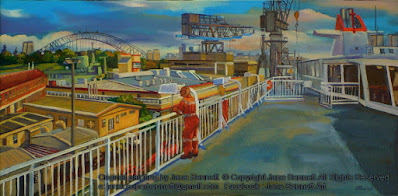All this winter I've felt something's been lacking.
Vivid.
Due to Covid-19 it couldn't be held this year, and for all I know New Year's Eve and Australia Day celebrations may not be held in the foreseeable future either.
I've often mocked Sydney for valuing style over substance, but I have to confess that I like a mindlessly pretty display of fairy lights against a harbour view as much as anyone.
So for anyone getting withdrawal symptoms, here's one on the easel of my deck gallery.

U118 Fireship under the Bridge
oil on canvas 2003 61 x 91cm
Available for sale
This canvas of the burning ship against a backdrop of fireworks illuminating the Sydney Harbour Bridge was painted in the studio from a series of quick gouache studies that I did on New Year's Eve 2003, well over a decade before Vivid was ever thought of. I regard this as a sort of 'proto-Vivid'.
It added a new dimension to the usual fireworks and was a startling sight if you weren't aware that it was in fact a special effect, and not a tragic fire on board the 'James Craig'.
The first time I saw it, like hundreds, possibly thousands of others, I rang 000 in a panic to report it. You could almost hear the person from Emergency Services rolling their eyes, as they assured me that it was just a special effect, that , no, the James Craig was just fine, and thanked me for my misplaced concern.
The Fireship apparently commemorated an early 19th century convict ship that had caught fire, and in the weeks after, during the Sydney Festival, there was a 'son et lumiere' show every night for a couple of weeks. I forget the details and the story, and frankly I think everyone else did as well. The images of the fire reflected in the water were all the spectators really were interested in, and the story seemed just a flimsy excuse.
As I painted some quick sketches in gouache and watercolour, I was glad that i'd spent so much of my 1996 Marten Bequest Traveling Art Scholarship holed up in the Print and Drawing Room of the Clore Gallery (the section of the Tate Gallery devoted to the work of Turner, obsessively painting studies of the many fabulous Turner watercolours in their collection. The Petworth series and the burning of the Houses of Parliament were my favourites. I became so good at painting them that the staff became slightly alarmed, and demanded that I sign my studies on the back so that I wouldn't be able to do a bit of a 'switcheroo' while their backs were turned! I took this as a sort of a backhanded compliment, but my goal wasn't to just mindlessly copy, but to try to conquer the mystery of painting sea,sky, storm, night and fire. How to make the intangible, tangible.
When I returned from my Traveling Art Scholarship, I actually exhibited some of these in a couple of exhibitions "The Grand Tour" and "In the Footsteps of the Masters" that acted like a sort of debriefing - a transition phase from the scholarship to the routine of regular commercial exhibitions.
I'd seen a lot of amazing art, and learnt a lot, but how was I going to incorporate this into what I would paint on my return?

U118 Fireship under the Bridge
oil on canvas 2003 61 x 91cm
Available for sale
Painting the Fireship was a chance to give a virtuoso display of layers of translucent glazes of breathtakingly expensive and exotic colours such as Aureolin, Rose Madder and Alizarin Crimson. These aren't the sort of colours that usually get a work out during plein air painting.
However, as I started to paint lost trades and dying industries, I would get more and more frequent opportunities to use them. Subjects like the Oxycutter at William Wallbank and Sons, or the Blacksmiths at the Eveleigh Railway Workshops provided further connections to the lost world of the Early Industrial Revolution that Turner and his predecessors de Loutherbourg and Joseph Wright of Derby immortalized. The major difference is that these artists were painting the founding of this era - I'm painting its demise.
Related Posts
Vivid
Meltdown, Oxycutting at William Wallbank and Sons
Irons in the fire



















